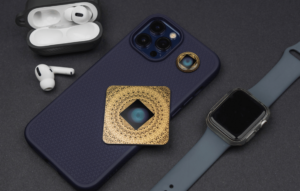Wearable technology like smartwatches and fitness trackers has become an extremely helpful tool for athletes and everyday people. From tracking heart rate and sleep to monitoring calories and recovery, these devices offer valuable insights into performance. However, growing concerns about the electromagnetic fields (EMF) emitted by these devices have sparked debates about their long-term health impacts.
Could these fitness tools actually be compromising your health through constant radiation exposure? And if so, what can you do to reduce EMF risks without losing the benefits of tracking? This article delves into the EMF concerns associated with wearables, comparing the Apple Watch vs. Fitbit vs. Samsung vs. Oura Ring EMF risks.
The EMF Dilemma: What Are Fitness Trackers Emitting?
Most modern fitness trackers and smartwatches emit non-ionizing radiation via Bluetooth, WiFi, and cellular connections. This radiation, in the form of electromagnetic fields, is similar to what smartphones emit—though smartwatches and trackers stay on the body much longer, increasing the exposure time.
 A key issue with wearables is their proximity to the body. When a smartwatch is strapped tightly to your wrist or a fitness tracker is worn for extended periods, EMF radiation is in direct contact with sensitive tissue, which could have potential biological effects. Regardless of what health officials may say, the research has proven time and time again that non-ionizing radiation can be detrimental to one’s health.
A key issue with wearables is their proximity to the body. When a smartwatch is strapped tightly to your wrist or a fitness tracker is worn for extended periods, EMF radiation is in direct contact with sensitive tissue, which could have potential biological effects. Regardless of what health officials may say, the research has proven time and time again that non-ionizing radiation can be detrimental to one’s health.
Greater Risk with Wearables?
Not all wearables emit the same levels of EMF. Oura Ring and Apple Watch, for instance, use different technologies to connect. Oura Ring uses Bluetooth, while the Apple Watch packs both Bluetooth and a cellular data feature, which requires significantly higher levels of radiation.
Cellular connectivity in smartwatches poses a greater risk because the device has to constantly communicate with the nearest cell tower, emitting EMF levels similar to a smartphone. Several findings are worth noting:
Cumulative EMF Dose: The longer you wear a device, the more EMF radiation your body absorbs. Although each burst of EMF may seem negligible, the exposure adds up over weeks, months, and years. This cumulative dose is what many researchers believe could lead to health issues, especially when EMFs are emitted close to the skin.
Oxidative Stress: As previously mentioned, research shows that EMFs can increase oxidative stress, which damages cells and leads to chronic inflammation. For athletes, this is particularly concerning as oxidative stress can hinder recovery, increase injury risk, and lead to long-term health issues.
Increased Cancer Risk: The International Agency for Research on Cancer (IARC) classified radiofrequency radiation as “possibly carcinogenic,” meaning it may contribute to the development of cancer over time. This is based on studies linking long-term exposure to devices like cell phones and wireless gadgets to a higher risk of brain tumors.
Specific Absorption Rate (SAR): How Much Radiation Are You Absorbing?
The radiation emitted by electronic devices is often measured using SAR (Specific Absorption Rate), which calculates the rate at which the body absorbs EMF radiation. It’s a standard set by regulatory organizations like the FCC, and although not perfect, it provides a rough idea of how much radiation a device emits.
Here’s how the SAR values compare between popular fitness devices:
- Oura Ring: 0.0003 W/kg (measured over 1 gram of tissue).
- Apple Watch Series 9 (GPS + Cellular): 1.15 W/kg (measured over 1 gram of tissue).
- Apple Watch Ultra: 0.93 W/kg (measured over 1 gram of tissue at 10mm separation).
- Samsung Galaxy Watch 5: 0.64 W/kg (measured over 1 gram of tissue).
Fitbit does not list its SAR measurements on its website, nor were they willing to give it out when contacted. We can assume, considering it has much fewer connectivity options than the Apple and Samsung watches, it would be somewhere between the Oura and Apple/Samsung in W/kg.
To put this all in perspective, the Apple Watch emits radiation at a level similar to that of the iPhone 14, which is concerning because, unlike a phone that you might store in your pocket or bag, the Apple Watch is worn tightly against your skin, often for hours or even days on end.
The Oura Ring emits far less radiation than these smartwatches, making it a much safer option for athletes concerned about the long-term effects of EMF exposure.
The Flaws of SAR Testing: Are We Getting the Full Picture?
Although SAR testing gives us a baseline measurement for EMF safety, experts point out several flaws in relying solely on this metric:
Focus on Thermal Effects: SAR tests primarily measure the thermal effects of radiation (how much it heats tissue), but they ignore non-thermal biological impacts, such as oxidative stress or disruption to cellular communication.
Short-Term Focus: SAR tests evaluate exposure based on short-term interactions, failing to account for the cumulative, long-term effects of wearing devices like fitness trackers every day.
User Demographics: SAR testing protocols don’t always represent the diverse demographics of actual users, especially vulnerable populations like children or pregnant women, who might be more sensitive to EMF exposure.
Lab Conditions vs. Real Life: SAR evaluations are conducted in controlled laboratory settings, which don’t always reflect how we use these devices in real life—constantly, and often near sensitive areas like wrists or heads.
Self-Reported Values: SAR values are often self-reported by manufacturers, leading to potential conflicts of interest. There’s a risk that some companies might underreport SAR levels to meet regulatory limits.
Airplane Mode: Reducing EMF Exposure While Tracking Health
Both the Oura Ring and Apple Watch offer Airplane Mode, which disables Bluetooth, WiFi, and cellular connectivity, drastically reducing EMF emissions. This feature can significantly limit your exposure to harmful radiation, but the difference between these two devices lies in what you lose when you turn it on.
The Oura Ring is designed purely for tracking health metrics, such as heart rate variability (HRV), sleep patterns, and activity levels. It continues to gather this essential health data even when Airplane Mode is activated. Since the Oura Ring’s primary function is health tracking, you can enjoy the benefit of reduced EMF exposure without losing any core functionality. You can simply sync your data later, after turning off Airplane Mode, without being connected all day.
On the other hand, the Apple Watch offers far more than just health tracking. It’s essentially an extension of your smartphone, offering notifications, messaging, phone calls, apps, and more. When Airplane Mode is activated on the Apple Watch, many of these core features are disabled, limiting its usefulness as a communication and productivity tool.
This leads to the bigger question: Do we really need this level of constant connectivity strapped to our bodies? While it may be convenient to receive notifications or messages directly on your wrist, it comes at the cost of continuous EMF exposure. The Oura Ring provides a simpler, health-focused solution without tethering you to the digital world 24/7, allowing athletes to prioritize their health while still tracking essential metrics.
Bacteria on Your Wearable: Another Risk to Consider
Besides EMF exposure, there’s another hidden risk when wearing devices like smartwatches: bacteria. A 2023 study from Florida Atlantic University found that 95% of smartwatch wristbands tested were contaminated with disease-causing bacteria, including Staphylococcus, Enterobacteria (like E. coli), and Pseudomonas. These bacteria can cause a variety of infections, including pneumonia, abscesses, and salmonella.
The study revealed that plastic and rubber bands on smartwatches harbored the most  bacteria, while metal bands like gold or silver were more resistant to contamination. For athletes who sweat frequently and use their wearables in the gym, this can be particularly concerning as moisture creates an ideal breeding ground for harmful bacteria.
bacteria, while metal bands like gold or silver were more resistant to contamination. For athletes who sweat frequently and use their wearables in the gym, this can be particularly concerning as moisture creates an ideal breeding ground for harmful bacteria.
Interestingly, the Oura Ring—made from titanium—is highly resistant to bacterial growth. This makes it a much more hygienic option compared to traditional wrist-worn devices, adding another layer of safety for athletes.
Aires Tech: A Proven EMF Protection Solution

For athletes who still want to use smartwatches or fitness trackers but are concerned about EMF exposure, Aires Tech provides an effective solution. Aires Tech’s line of products, such as the Lifetune Go and Lifetune Flex, are designed to neutralize the harmful effects of EMF radiation by modulating the frequencies into a form that the body can better tolerate.
By wearing Aires Tech products alongside your smartwatch or fitness tracker, you can significantly reduce the oxidative stress and other potential negative effects caused by EMF exposure. This makes it an excellent solution for athletes who want to balance the benefits of wearable technology with their long-term health and well-being.
Practical Tips for Reducing EMF Exposure from Wearables
Besides switching to low-EMF devices like the Oura Ring and using Aires Tech protection, here are some additional ways to reduce EMF exposure from wearables:
Limit Wear Time: Only wear your smartwatch or fitness tracker during workouts or periods when you need specific data. This reduces your overall exposure time.
Avoid Sleeping with Your Device: If possible, avoid wearing fitness trackers to bed. EMF exposure during sleep can disrupt melatonin production, leading to poorer sleep quality and recovery.
Use Wired Connections: Whenever possible, opt for wired connections over wireless ones to reduce the EMF load in your environment.
Practice Grounding: Spend time outdoors in nature, particularly walking barefoot on grass or soil. Grounding helps discharge EMF build-up in the body, restoring your body’s natural balance.
Conclusion: Prioritize Your Health, Even in the Digital Age
There’s no denying the convenience and benefits of wearable technology, but it’s essential to remain cautious about the hidden risks. EMF exposure, bacterial contamination, and long-term health effects are all valid concerns for athletes who wear fitness trackers and smartwatches daily.
By choosing low-EMF options like the Oura Ring, utilizing Airplane Mode, and incorporating EMF protection like Aires Tech, athletes can continue tracking their performance and recovery without compromising their health. In the world of elite performance, it’s not just about training harder—it’s about training smarter and safer.






